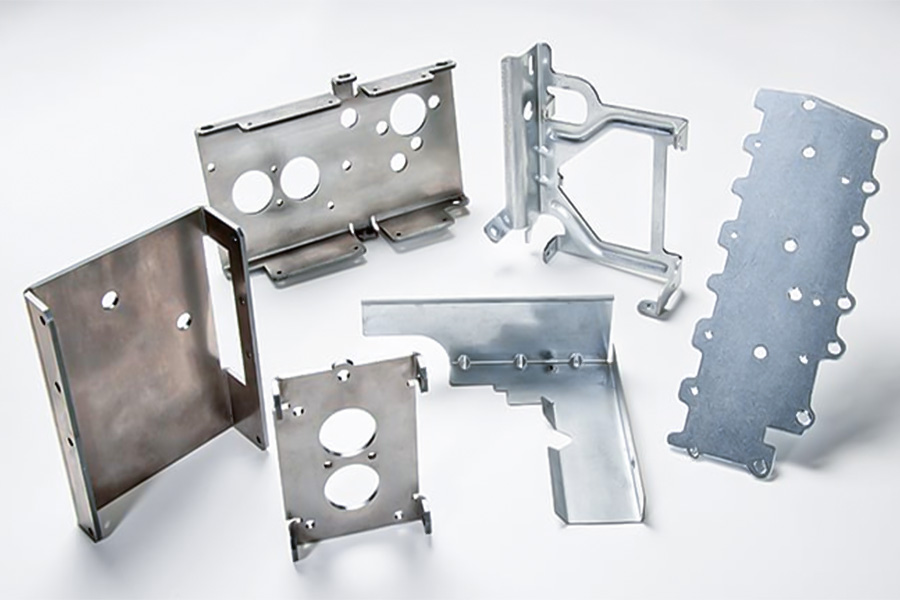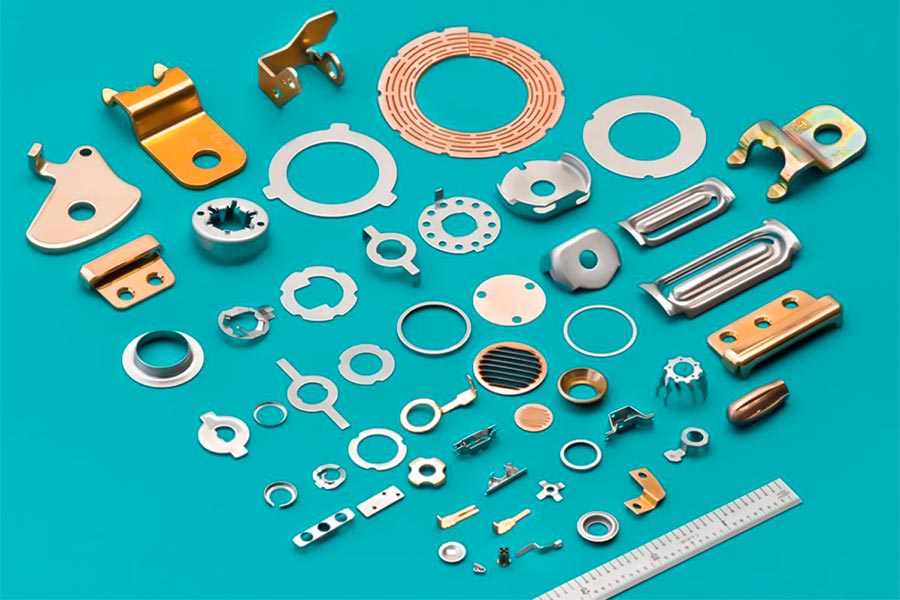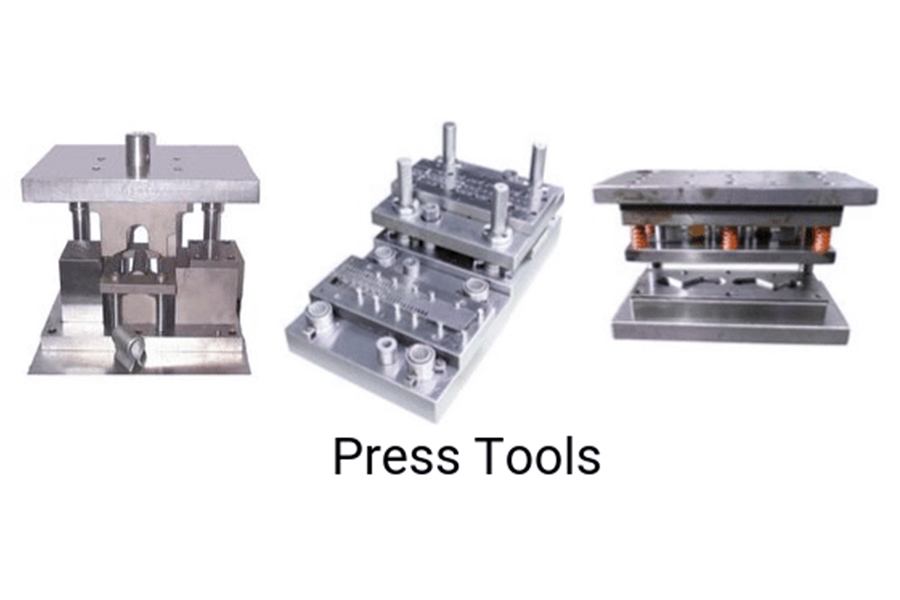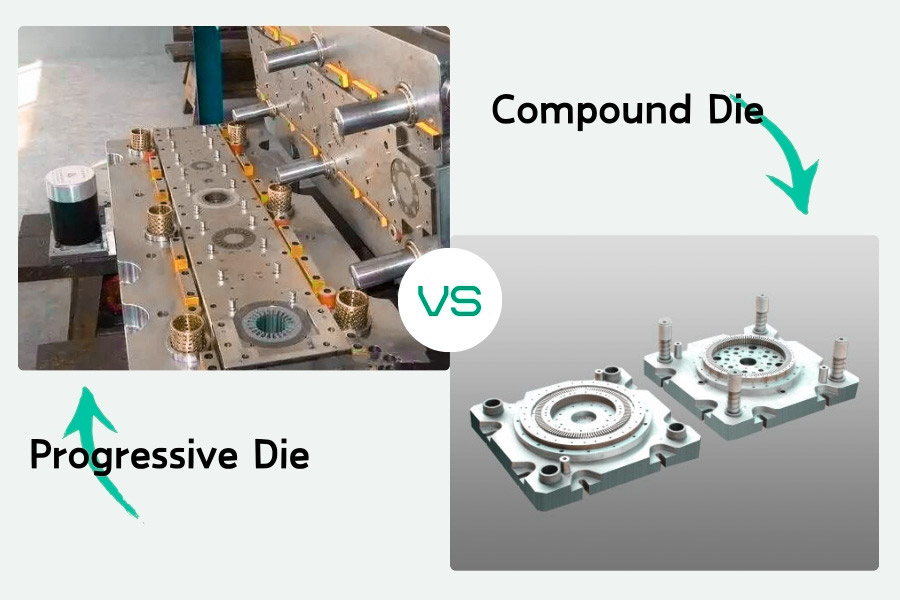Progressive die stamping is an important metal processing technologyand is widely used in industries such as automobiles, electrical appliances, machinery manufacturing and home appliances. In the progressive die stamping process, it is crucial to select the appropriate mold material. It not only affects the service life and performance of the mold, but also directly affects the quality and production efficiency of the product. This article will introduce in detail severalmaterials commonly used in progressive die stamping.
What is Progressive Die Stamping?
Progressive die stamping, as the name suggests, uses a complex mold structure to achieve multiple,multi-step stamping processingof metal sheets in a continuous process flow. This technology breaks the limitations of traditional single-station stamping, integrates multiple processes into one mold, and realizes continuous operations from material feeding, preliminary blanking, complex bending, stretch forming to final cutting. Every step of the operation is closely connected, like a precision automated machine, gradually transforming metal sheets into finished parts that meet the design requirements.

What Materials Are Used in progressive die stamping?
As an efficient and accurate metal forming process, progressive die stamping is widely used in manufacturing, especially in the fields of automobiles, electronics, aerospace and other fields. In the progressive die stamping process, it is crucial to choose the right material, which directly affects the life of the mold, product quality and production efficiency. The following is an overview of the commonly usedmetallic materials used in progressive die stamping, as well as the occasionally used non-metallic materials.
Metallic materials
1.Steel
- Mild steel:Due to its good ductility and relatively low price, it is suitable for general stamping applications.Mild steelis easy to form and suitable for high-volume production.
- Stainless steel:It has excellent corrosion resistance and is suitable for parts that need to be used in wet or corrosive environments.Stainless steelis generally stronger and harder than mild steel, so mold design needs to take these properties into account.
2.Aluminum
Lightweight, strong and corrosion-resistant, it is a commonly used material in the automotive and aerospace fields.Aluminum alloys have good stampingand forming properties, which can be made into complex shapes while reducing product weight.
3.Brass and Copper
These materials are widely used in electrical components and decorative parts due to their good electrical conductivity and corrosion resistance.Brass and copper are better formablebut relatively costly and are often used in small batches or high-value products.
4.Special alloys
Including high-strength steel, heat-resistant alloys, etc., for parts that require high strength, high hardness, or high temperature resistance. These materials are more demanding on the mold because they are difficult to form and more abrasive.
Non-metallic materials
In progressive die stamping, the use ofnon-metallic materialsis relatively rare, but it may be encountered in some special applications. These materials are usually applied to metal substrates as composite layers or special functional layers.
- Composite materials:such as carbon fiber reinforced plastic (CFRP), glass fiber reinforced plastic (GFRP), etc. These materials have the advantages of high strength, low weight and corrosion resistance, but are difficult to form and usually require special mold design and stamping technology.
- Special coatings or laminates:In some applications, a metal substrate may be coated with a special material, such as an anti-corrosion coating, a wear-resistant coating, or a conductive coating, to meet specific performance requirements.

What factors need to be considered when selecting materials?
Whenselecting progressive die stamping materials, the main factors to consider include:
- Plasticity of the material:Good plasticity helps the material to be formed more easily in the multi-station deformation process, reduces the required deformation force, and improves the mold life and yield.
- Material strength and hardness:Appropriate strength and hardness can ensure that the material maintains shape stability during the stamping process and is not prone to cracks or deformation.
- Material surface condition:A smooth and flat surface helps reduce mold scratches and improves the quality of parts.
- Stamping performance of the material: The material should be easy to accept various stamping processes, such as bending, drawing, etc.
- Material specifications and quality:Material thickness tolerance, width dimensions, straightness, length and other specifications must meet the requirements of progressive die stamping to ensure smooth feeding and product quality.
- Economics and availability of materials:Materials should be reasonably priced and easily available to reduce production costs and ensure production continuity.
What are the advantages and disadvantages of progressive die stamping?
As an efficient metal forming technology,progressive die stamping has wide applicationsin the manufacturing industry. The following are the mainadvantages and disadvantages of progressive die stamping:
Advantages
Progressive die stamping has several advantages over other stamping methods, such as four-slide or multi-slide machines.
- Less time to set up:Progressive die stamping takes 38% less time to set up than multi-slide stamping. This allows producers to generate smaller lot sizes and make manufacturing scheduling more flexible to produce what the client wants when they need it. It also reduces the labor involved in the production of parts.
- Repeatability:The machines provide excellent repeatability with tight tolerances. They can generate large quantities of parts without compromising quality.
- High accuracy:Because each station performs a different operation, progressive die stamping is highly efficient and can be used to produce large quantities of parts with a high degree of accuracy.
- Generic Tooling:Because of the simple nature of the forming process, using only vertical pressure, it is possible to move tooling from one supplier to another without the need for a major retrofit. Generally if a press machine of the same tonnage and bed size is available a tool build to run on that bed size and tonnage will be able to run in a different press.
Disadvantages
While there are manyadvantages to using progressive die stampingforsheet metal fabrication, there are also some drawbacks to consider:
- Expense:One of the biggest disadvantages is the high initial investment cost. Die sets for progressive die stamping can be very costly, and businesses need to be sure that they can generate enough work to justify the expense.
- Limited operations:Progressive die stamping can only be used for certain projects. Some part features may not be possible to produce inside a progressive die.
- Continuity:Finally, progressive die stamping can be very complex and time-consuming (especially since setups have to be configured or reconfigured for each project). This makes it hard to switch between projects quickly.
- More waste:Progressive die stamping produces waste. Due to the fact that the part must be carried on the strip throughout the entire process there is inherent waste caused by the material needed to keep the part on the strip until the very last step. Although the waste material can be recycled, when working with material such as copper or brass this process can be less cost effective.

What are the applications of progressive die stamping?
As a versatile andprecise metal fabrication process, you’ll see components produced by thisstamping methodacross a host of industries and applications:
- Automotive:Progressive die stamping is critical in the automotive industryfor manufacturing large volumes of precision parts such as brackets, panels, and various engine components. This process allows for the rapid production of complex shapes that are essential in vehicle assembly.
- Electronics: In electronics, this technique is used to create small, intricate parts that require high precision, such as connectors, terminals, and shields. These components often require tight tolerances and high repeatability, whichprogressive die stamping can achieve efficiently.
- Aerospace: For the aerospace industry,progressive die stamping is used to produce lightweight, durable components crucial for the structural and engine parts of aircraft. This includes items like shims, brackets, and various other metal fittings that need to meet stringent regulatory standards.
- Telecommunications: This process is employed in the telecommunications sector to manufacture components found in infrastructure and hardware, such as antenna parts and electronic enclosures. These parts need to be consistently reliable to ensure long-term functionality and service.
- Construction: In construction, progressive die stamping is utilized to make structural components, fasteners, and fittings. These items must be robust and able to withstand environmental stressors, making the high-strength outputs of progressive die stamping ideal.
- Medical:The medical field uses progressive die stamping to create componentsthat are part of medical devices. These parts, such as brackets, small containers, and surgical tools, require high precision and must adhere to strict hygiene and safety standards.
What is the difference between progressive die and composite die?
Progressive die and compound dieare concepts in two different fields, representing different concepts and application scenarios respectively. The table below is a detailed comparison of the two:
| Progressive | Compound die | |
| Definitions and characteristics | Gradual and small improvements and adjustments on the existing basis | The die structure of the punch to complete multiple processes in one stroke |
| Fields of application | Software development, policy development, change management, etc | Metal fabrication processes, especially for parts with complex shapes and high precision |
| Phases and iterations | Clear demarcation of phases to support iterative development and requirements changes | The structure is compact, multiple processes are completed at the same station, and iteration is not supported |
| Risk and stability | Risks are controllable, and risks are reduced through testing and validation, and the system is kept running stably | The mold structure is complex, the risk is relatively high, but the production efficiency is high |
| Cost & Efficiency | The cost is relatively low (depending on the number of iterations and complexity), and the efficiency is gradually improved | The cost is high (long mold manufacturing cycle), but the production efficiency is extremely high |
| Precision and quality | Accuracy and quality are based on the number of iterations and test validation | High precision, good coaxiality of punching parts, straight surface, high dimensional accuracy |
| flexibility | Highly flexible and able to respond to changes in demand and uncertainties in the external environment | Flexibility is relatively low, and once the mold is made, it is difficult to make major changes |
FAQs
1.What types of materials are mainly used in progressive die stamping?
Themain materials used in progressive die stampinginclude metal plates and metal strips. These materials can be mild steel, stainless steel, aluminum and aluminum alloys, copper and copper alloys, etc. These metal materials have good ductility, strength and plasticity, and are suitable for complex stamping processing.
2.Why choose these materials for progressive die stamping?
The main reasons for choosing these materials are: Good stamping performance: These materials are not easy to break or deform during the stamping process, and can maintain high accuracy and consistency. High strength and wear resistance: These materials have high strength and wear resistance, which can resist friction and wear during the stamping process and extend the service life of the mold. Good workability: These materials are easy to cut, bend and form, making them suitable for complex stamping processes.
3.What are progressive die stamping machines used for?
Progressive die stamping machinestypically use high-speed punches with computer control. This kind of punch machine has the characteristics of high speed, high precision, precise pressure control, high degree of intelligence, low noise and low energy consumption. It can realize the transformation of different processing requirements by adjusting the punch stroke and stroke depth, and has good flexibility. In addition, the progressive die stamping machine may also be equipped with auxiliary equipment such as automatic feeding devices, waste processing systems, and intelligent control systems to achieve automated production.
4.What materials are stamping dies made of?
Commonly usedmaterials for stamping diesmainly include steel, cemented carbide, steel-bonded cemented carbide, zinc-based alloys, polymer materials, aluminum bronze and low melting point alloys. Among them, most stamping dies are mainly made of steel. Commonly used mold working parts materials include carbon tool steel, low alloy tool steel, high carbon high chromium or medium chromium tool steel, medium carbon alloy steel, high speed steel, matrix steel and Carbide, steel bonded carbide, etc. The selection of these materials is mainly based on factors such as the mold's working conditions, service life, manufacturing cost, and material processing properties.
Summary
Thematerials used in progressive die stamping have a significant impacton their performance and product quality. By rationally selecting mold materials and processed materials, the efficiency, accuracy and stability of progressive die stamping can be ensured. At the same time, considering factors such as the specific requirements of the product, production efficiency, cost and sustainability will help optimize material selection and improve the market competitiveness of the product.
Disclaimer
The content on this page is for reference only.LSdoes not make any express or implied representation or warranty as to the accuracy, completeness or validity of the information. No performance parameters, geometric tolerances, specific design features, material quality and type or workmanship should be inferred as to what a third party supplier or manufacturer will deliver through the Longsheng Network. It is the responsibility of the buyerseeking a quote for partsto determine the specific requirements for those parts.Pleasecontact usfor moreinformation.
LS Team
LS is an industry-leading companyspecializing in custom manufacturing solutions. With over 20 years of experience serving more than 5,000 clients, we focus on high-precisionCNC machining,sheet metal fabrication,3D printing,injection molding,metal stamping,and other one-stop manufacturing services.
Our factory is equipped with more than 100 advanced 5-axis machining centers and is ISO 9001:2015 certified. We provide fast, efficient, and high-quality manufacturing solutions to customers in over 150 countries worldwide. Whether it’s low-volume production or large-scale customization, we can meet your needs with delivery as fast as 24 hours.
ChoosingLS Technologymeans choosing efficiency, quality, and professionalism.
To learn more, please visit our website:www.lsrpf.com







